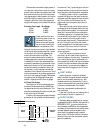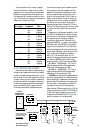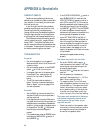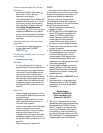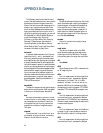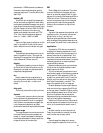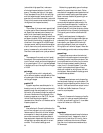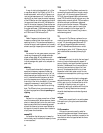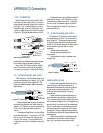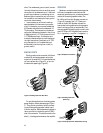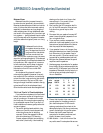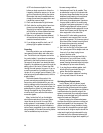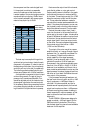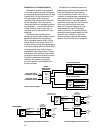31
Maintaining proper circuit impedance rela-
tionships is important to avoid distortion and
minimize added noise. Mackie input and out-
put impedances are designed to work well with
the vast majority of audio equipment.
knee
A knee is a sharp bend in an EQ response
curve not unlike the sharp bend in your leg.
Also used in describing dynamics processors.
level
Another word for signal voltage, power,
strength, or volume. Audio signals are some-
times classified according to their level.
Commonly used levels are: microphone level
(–40 dBu or lower), instrument level (–20 to
–10 dBu), and line level (–10 to +30 dBu).
line level
A signal whose level falls between –10 dBu
and +30 dBu.
master
A control affecting the final output of a
mixer. A mixer may have several master con-
trols, which may be slide faders or rotary
controls.
mixer
An electronic device used to combine vari-
ous audio signals into a common output.
Different from a blender, which combines vari-
ous fruits into a common libation.
monaural
Literally, pertaining to or having the use of
only one ear. In sound work, monaural has to
do with a signal which, for purposes of commu-
nicating audio information, has been confined
to a single channel. One microphone is a mono
pickup; many microphones mixed to one chan-
nel is a mono mix; a mono signal played
through two speakers is still mono, since it only
carries one channel of information. Several
monaural sources, however, can be panned
into a stereo (or at least two-channel, if you are
going to be picky) mix. Monaural sound rein-
forcement is common for environments where
stereo sound reinforcement would provide an
uneven reproduction to the listener.
monitor
In sound reinforcement, monitor speakers
(or monitor headphones or in-the-ear
monitors) are those speakers used by the per-
formers to hear themselves. Monitor speakers
are also called foldback speakers. In recording,
the monitor speakers are those used by the
production staff to listen to the recording as it
progresses. In zoology, the monitor lizard is the
lizard that observes the production staff as the
recording progresses. Keep the lizard out of the
mixer.
noise
Whatever you don’t want to hear. Could be
hum, buzz, or hiss; could be crosstalk or digital
hash or your neighbor’s stereo; could be white
noise or pink noise or brown noise; or it could
be your mother-in-law reliving the day she had
her gallstone removed.
noise floor
The residual level of noise in any system. In
a well-designed product, the noise floor will be
a very quiet hiss, which is the thermal noise
generated by bouncing electrons in the transis-
tor junctions. The lower the noise floor and the
higher the headroom, the more usable dynamic
range a system has.
parametric EQ
A “fully” parametric EQ is an extremely pow-
erful equalizer that allows smooth, continuous
control of each of the three primary EQ param-
eters (frequency, gain, and bandwidth) in each
section independently. “Semi” parametric EQs
allow control of fewer parameters, usually fre-
quency and gain (i.e., they have a fixed
bandwidth, but variable center frequency and
gain).
peaking
The opposite of dipping, of course. A peak
is an EQ curve that looks like a hill, or a peak.
Peaking with an equalizer amplifies a band of
frequencies.
phone jack
Ever see those old telephone switchboards
with hundreds of jacks and patch cords and
plugs? Those are phone jacks and plugs, now
widely used with musical instruments and
audio equipment. A phone jack is the female
connector, and we use them in 1⁄4" two-con-
ductor (TS) and three-conductor (TRS)
versions.
phone plug
The male counterpart to the phone jack.
See above.




